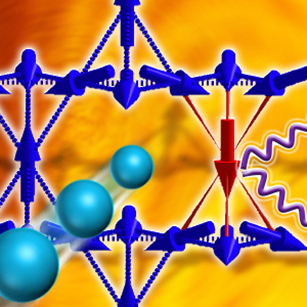Electrons have a fundamental property called “spin,” which is the building block of magnetism. When all the spins point in the same direction one of the simplest and best-known uses of magnetism occurs: the refrigerator magnet. There are, however, many more complex ways the spins can be arranged at the atomic level that yield potentially technologically useful materials properties. An often neglected property of an electron’s spin is that it can be influenced by the electron’s motion thanks to the so-called “spin-orbit interaction.” In many materials, this interaction is small enough to be ignored. In some materials, however, this interaction can change the energy of an electron enough to have a huge effect on the properties of a sample. To accurately determine relative energies of the electrons and signatures of the spin-orbit interaction in an oxide material, resonant inelastic x-ray scattering (RIXS) experiments were performed at the U.S. Department of Energy’s (DOE’s) Advanced Photon Source (APS). The results reveal divergent behavior than found from RIXS measurements in related iridates that are candidates for developing high-temperature superconductors.
Cd2Os2O7 is an oxide material in which the way the spins are arranged is expected to be particularly important to the observed behavior. At room temperature the spins point in random directions and the material is a metal. Cooling the material below -55° F causes a dramatic change: at the same point the spins arrange in a repeating pattern and the material becomes electrically insulating (the electrons stop flowing). Exactly how the spins are arranged and the influence of the spin-orbit interaction in Cd2Os2O7has, until this study, remained an open question.
The first step by the researchers in this study, from Oak Ridge National Laboratory, University College London (UK), IFW Dresden (Germany), Brookhaven National Laboratory, the Chinese Academy of Sciences, Argonne, the University of Tennessee, and Technische Universität Dresden (Germany) was to determine the order and orientation of the spins of the electrons in the material via neutron diffraction experiments at the DOE’s High Flux Isotope Reactor (HFIR) at Oak Ridge National Laboratory. This provided experimental confirmation of an existing theory: The spins are arranged in a configuration called “all-in-all-out” (Fig 1). In this configuration, the electron spins on the osmium atoms point in to, or away from, a common central point. Determining the spin configuration will help scientists to understand why this material has a rare simultaneous change of magnetism and electrical conductivity.
The specific type of spin-ordering found has a further, potentially more profound, consequence. Recent theory predicts that such a spin arrangement will yield a rare particle called a “Weyl fermion,” normally destroyed in magnetic materials. This particle is similar to the electron; however, it can travel much faster than electrons. This makes it ideal as a potential route to produce faster electronic devices, which are currently limited by the speed of electrons. One key ingredient for the creation of Weyl fermions is large spin-orbit interaction. However, it was believed that this interaction in Cd2Os2O7 was suppressed and has often been ignored.
The energy differences between different electrons in the sample were measured via RIXS at the APS (both the APS and the HFIR are Office of Science user facilities). From these measurements, the researchers determined the influence of the spin-orbit interaction. How the electrons are arranged in the atoms in the material could be described without considering the spin-orbit interaction. However, the way the spins interact and arrange themselves in the material is strongly influenced by spin-orbit interaction as revealed by the RIXS experimental features.
This study suggests that the spin-orbit interaction in Cd2Os2O7 is strong and has a spin arrangement that makes it a candidate for finding Weyl fermions within a magnetic material. These new measurements illustrate how much diversity of electronic behavior is found across the 5d TMOs.
See: S. Calder1*, J.G. Vale2, N.A. Bogdanov3, X. Liu4,5, C. Donnerer2, M.H. Upton6, D. Casa6, A.H. Said6, M.D. Lumsden1, Z. Zhao1,7, J.-Q. Yan1,7, D. Mandrus1,7, S. Nishimoto3,8, J. van den Brink3, J. P. Hill4, D.F. McMorrow1, and A. D. Christianson1,7, “Spin-orbit driven magnetic structure and excitation in the 5d pyrochlore Cd2Os2O7,” Nat. Commun. 7( 11651) (published online 07 June 2016). DOI: 10.1038/ncomms11651
Author affiliations: 1Oak Ridge National Laboratory, 2University College London, 3IFW Dresden, 4Brookhaven National Laboratory, 5Chinese Academy of Sciences, 6Argonne National Laboratory, 7University of Tennessee, 8Technische Universität Dresden
Correspondence: *[email protected]
Work at the High Flux Isotope reactor was supported by the Scientific User Facilities Division, Basic Energy Sciences, U.S. DOE Office of Science. Work in London was supported by the EPSRC. Work in Dresden was supported by the German Research Foundation (SFB 1143 of the Deutsche Forschungsgemeinschaft). Work performed at Brookhaven National Laboratory was supported by the U.S. DOE under contract no. contract no. DE-SC0012704.
This research used resources of the Advanced Photon Source, a U.S. DOE Office of Science User Facility operated for the U.S. DOE Office of Science by Argonne National Laboratory under Contract No. DE-AC02-06CH11357.
Argonne National Laboratory is supported by the Office of Science of the U.S. Department of Energy. The Office of Science is the single largest supporter of basic research in the physical sciences in the United States, and is working to address some of the most pressing challenges of our time. For more information, please visit science.energy.gov.

